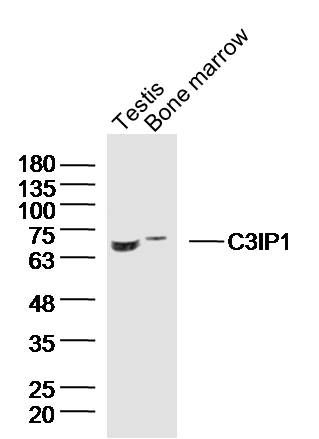C3IP1 Polyclonal Antibody
Purified Rabbit Polyclonal Antibody (Pab)
- SPECIFICATION
- CITATIONS
- PROTOCOLS
- BACKGROUND

Application
| WB, IHC-P, IHC-F, IF, ICC, E |
|---|---|
| Primary Accession | Q53G59 |
| Reactivity | Rat, Pig, Dog |
| Host | Rabbit |
| Clonality | Polyclonal |
| Calculated MW | 63 KDa |
| Physical State | Liquid |
| Immunogen | KLH conjugated synthetic peptide derived from human C3IP1 |
| Epitope Specificity | 1-100/568 |
| Isotype | IgG |
| Purity | affinity purified by Protein A |
| Buffer | 0.01M TBS (pH7.4) with 1% BSA, 0.02% Proclin300 and 50% Glycerol. |
| SUBCELLULAR LOCATION | Cytoplasmic vesicle, COPII-coated vesicle. |
| SIMILARITY | Contains 1 BACK (BTB/Kelch associated) domain. Contains 1 BTB (POZ) domain. Contains 6 Kelch repeats. |
| SUBUNIT | Component of the BCR(KLHL12) E3 ubiquitin ligase complex, at least composed of CUL3 and KLHL12 and RBX1. This complex interacts with DVL3 upon activation of the Wnt signaling pathway by WNT3A. Interacts with DRD4, KLHL12 and SEC31A. |
| Important Note | This product as supplied is intended for research use only, not for use in human, therapeutic or diagnostic applications. |
| Background Descriptions | KLHL12 is a 568 amino acid protein that is a component of an ubiquitin-protein E3 ligase complex, which includes at least CUL-3. KLHL12 is a substrate-specific adapter for the complex, which negatively regulates the Wnt signaling pathway via the targeted ubiquitination and subsequent proteolysis of Dvl-3. KLHL12 contains six Kelch repeats and one BTB (POZ) domain, which is required for interaction with CUL-3. KLHL12 has highest expression in testis, with lower levels found in the submandibular salivary gland. The gene that encodes KLHL12 maps to human chromosome 1q32.1 |
| Gene ID | 59349 |
|---|---|
| Other Names | Kelch-like protein 12, CUL3-interacting protein 1 {ECO:0000303|Ref.1}, DKIR homolog, hDKIR, KLHL12, C3IP1 {ECO:0000303|Ref.1} |
| Target/Specificity | Ubiquitously expressed. Highly expressed in testis and at lower levels in the submandibular salivary gland. |
| Dilution | WB=1:500-2000,IHC-P=1:100-500,IHC-F=1:100-500,ICC=1:100-500,IF=1:100-500,ELISA=1:5000-10000 |
| Storage | Store at -20 ℃ for one year. Avoid repeated freeze/thaw cycles. When reconstituted in sterile pH 7.4 0.01M PBS or diluent of antibody the antibody is stable for at least two weeks at 2-4 ℃. |
| Name | KLHL12 |
|---|---|
| Synonyms | C3IP1 {ECO:0000303|Ref.1} |
| Function | Substrate-specific adapter of a BCR (BTB-CUL3-RBX1) E3 ubiquitin ligase complex that acts as a negative regulator of Wnt signaling pathway and ER-Golgi transport (PubMed:22358839, PubMed:27565346). The BCR(KLHL12) complex is involved in ER-Golgi transport by regulating the size of COPII coats, thereby playing a key role in collagen export, which is required for embryonic stem (ES) cells division: BCR(KLHL12) acts by mediating monoubiquitination of SEC31 (SEC31A or SEC31B) (PubMed:22358839, PubMed:27565346). The BCR(KLHL12) complex is also involved in neural crest specification: in response to cytosolic calcium increase, interacts with the heterodimer formed with PEF1 and PDCD6/ALG-2, leading to bridge together the BCR(KLHL12) complex and SEC31 (SEC31A or SEC31B), promoting monoubiquitination of SEC31 and subsequent collagen export (PubMed:27716508). As part of the BCR(KLHL12) complex, also acts as a negative regulator of the Wnt signaling pathway by mediating ubiquitination and subsequent proteolysis of DVL3 (PubMed:16547521). The BCR(KLHL12) complex also mediates polyubiquitination of DRD4 and PEF1, without leading to degradation of these proteins (PubMed:18303015, PubMed:20100572, PubMed:27716508). |
| Cellular Location | Cytoplasmic vesicle, COPII-coated vesicle |
| Tissue Location | Ubiquitously expressed. Highly expressed in testis and at lower levels in the submandibular salivary gland |

Thousands of laboratories across the world have published research that depended on the performance of antibodies from Abcepta to advance their research. Check out links to articles that cite our products in major peer-reviewed journals, organized by research category.
info@abcepta.com, and receive a free "I Love Antibodies" mug.
Provided below are standard protocols that you may find useful for product applications.
If you have used an Abcepta product and would like to share how it has performed, please click on the "Submit Review" button and provide the requested information. Our staff will examine and post your review and contact you if needed.
If you have any additional inquiries please email technical services at tech@abcepta.com.













 Foundational characteristics of cancer include proliferation, angiogenesis, migration, evasion of apoptosis, and cellular immortality. Find key markers for these cellular processes and antibodies to detect them.
Foundational characteristics of cancer include proliferation, angiogenesis, migration, evasion of apoptosis, and cellular immortality. Find key markers for these cellular processes and antibodies to detect them. The SUMOplot™ Analysis Program predicts and scores sumoylation sites in your protein. SUMOylation is a post-translational modification involved in various cellular processes, such as nuclear-cytosolic transport, transcriptional regulation, apoptosis, protein stability, response to stress, and progression through the cell cycle.
The SUMOplot™ Analysis Program predicts and scores sumoylation sites in your protein. SUMOylation is a post-translational modification involved in various cellular processes, such as nuclear-cytosolic transport, transcriptional regulation, apoptosis, protein stability, response to stress, and progression through the cell cycle. The Autophagy Receptor Motif Plotter predicts and scores autophagy receptor binding sites in your protein. Identifying proteins connected to this pathway is critical to understanding the role of autophagy in physiological as well as pathological processes such as development, differentiation, neurodegenerative diseases, stress, infection, and cancer.
The Autophagy Receptor Motif Plotter predicts and scores autophagy receptor binding sites in your protein. Identifying proteins connected to this pathway is critical to understanding the role of autophagy in physiological as well as pathological processes such as development, differentiation, neurodegenerative diseases, stress, infection, and cancer.


